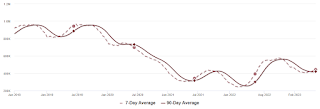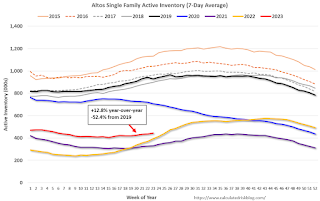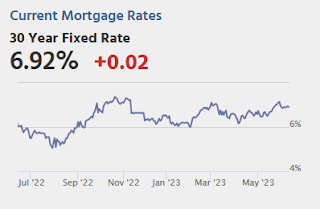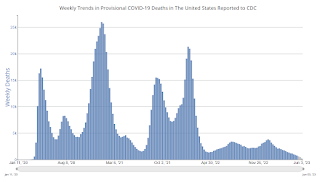by Calculated Risk on 6/12/2023 11:39:00 AM
Monday, June 12, 2023
2nd Look at Local Housing Markets in May
Today, in the Calculated Risk Real Estate Newsletter: 2nd Look at Local Housing Markets in May
A brief excerpt:
This is the second look at local markets in May. I’m tracking about 40 local housing markets in the US. Some of the 40 markets are states, and some are metropolitan areas. I’ll update these tables throughout the month as additional data is released.There is much more in the article. You can subscribe at https://calculatedrisk.substack.com/
Closed sales in May were mostly for contracts signed in March and April. Since 30-year fixed mortgage rates were in the 6% to 6.5% range in March and April - compared to the 4% to 5% range the previous year - closed sales were down significantly year-over-year in May.
...
In May, sales in these markets were down 16.2%. In April, these same markets were down 23.6% YoY Not Seasonally Adjusted (NSA).
This is a smaller YoY decline NSA than in April for these markets, however seasonally adjusted, it is closer since there was one less selling day in April this year than in April 2022, but the same number of selling days each year in May.
Another factor in the smaller YoY decline was that sales were steadily declining last year due to higher mortgage rates. This graph shows existing home sales by month for 2022 and 2023, on a Seasonally Adjusted Annual Rate (SAAR) basis.
If sales were steady all year, the YoY decline would still decrease!
...
Many more local markets to come!
Housing June 12th Weekly Update: Inventory Increased 1.5% Week-over-week
by Calculated Risk on 6/12/2023 08:17:00 AM
 Click on graph for larger image.
Click on graph for larger image.This inventory graph is courtesy of Altos Research.

Sunday, June 11, 2023
Sunday Night Futures
by Calculated Risk on 6/11/2023 06:12:00 PM
Weekend:
• Schedule for Week of June 11, 2023
Monday:
• No major economic releases scheduled.
From CNBC: Pre-Market Data and Bloomberg futures S&P 500 and DOW futures are mostly unchanged (fair value).
Oil prices were down over the last week with WTI futures at $70.17 per barrel and Brent at $74.79 per barrel. A year ago, WTI was at $121, and Brent was at $127 - so WTI oil prices are down over 40% year-over-year.
Here is a graph from Gasbuddy.com for nationwide gasoline prices. Nationally prices are at $3.57 per gallon. A year ago, prices were at $5.02 per gallon, so gasoline prices are down $1.45 per gallon year-over-year.
FOMC Preview: A Likely "Pause"
by Calculated Risk on 6/11/2023 08:11:00 AM
Most analysts expect the FOMC to "pause" raising rates at the meeting this week.
"In determining the extent to which additional policy firming may be appropriate to return inflation to 2 percent over time, the Committee will take into account the cumulative tightening of monetary policy, the lags with which monetary policy affects economic activity and inflation, and economic and financial developments."
emphasis
"We expect the Fed to maintain the target range for the federal funds rate at 5.0-5.25% at the June FOMC meeting, while it assesses monetary policy lags and bank stress. That said, a skip is not the same as a prolonged pause. With the debt limit increased and bank stress relatively stable - it may not be getting much better, but it also does not appear to be getting much worse - the Fed's primary concern remains inflation and it will be reluctant to say definitively that the hiking cycle is over. Hence, we expect the Fed to retain upward bias in its projected policy rate path and we look for the median FOMC member to forecast one additional 25bp rate hike by year-end, for a terminal target range of 5.25-5.50%. In addition, we think the median forecast for year-end 2024 will rise by 37.5bp to 4.5-4.75%, signaling increased willingness to maintain a "higher-for-longer" policy stance to bring inflation down with greater confidence."And from Goldman Sachs economists:
emphasis added
The FOMC is likely to pause at its June meeting next week to let the haze clear before it considers another rate hike. The Fed leadership has signaled that it sees pausing as the prudent course because uncertainty about both the lagged effects of the rate hikes it has already delivered and the impact of tighter bank credit increases the risk of accidentally overtightening. ... We expect the median dot to show one additional hike to a new peak of 5.25-5.5%, in line with our own forecast.
| GDP projections of Federal Reserve Governors and Reserve Bank presidents, Change in Real GDP1 | ||||
|---|---|---|---|---|
| Projection Date | 2023 | 2024 | 2025 | |
| Mar 2023 | 0.0 to 0.8 | 1.0 to 1.5 | 1.7 to 2.1 | |
The unemployment rate was at 3.7% in May. To reach the mid-point of the FOMC projections for Q4 2023, the economy would likely have to lose over 1 million jobs by Q4. The FOMC will likely lower their unemployment rate projection for Q4.
| Unemployment projections of Federal Reserve Governors and Reserve Bank presidents, Unemployment Rate2 | ||||
|---|---|---|---|---|
| Projection Date | 2023 | 2024 | 2025 | |
| Mar 2023 | 4.0 to 4.7 | 4.3 to 4.9 | 4.3 to 4.8 | |
As of April 2023, PCE inflation increased 4.4 percent year-over-year (YoY), up from 4.2 percent YoY in March, and down from the recent peak of 7.0 percent in June 2022. The projection of PCE inflation for Q4 2023 will might be revised up slightly, however May and June 2022 PCE inflation was very high, and YoY PCE inflation will likely decrease sharply over the next two months.
| Inflation projections of Federal Reserve Governors and Reserve Bank presidents, PCE Inflation1 | ||||
|---|---|---|---|---|
| Projection Date | 2023 | 2024 | 2025 | |
| Mar 2023 | 3.0 to 3.8 | 2.2 to 2.8 | 2.0 to 2.2 | |
PCE core inflation increased 4.7 percent YoY, up from 4.6 percent in March, and down from the recent peak of 5.4 percent in February 2022.; This remains a concern for the FOMC, however this includes shelter that was up 8.4% YoY in April (even though asking rents are mostly unchanged YoY).
| Core Inflation projections of Federal Reserve Governors and Reserve Bank presidents, Core Inflation1 | ||||
|---|---|---|---|---|
| Projection Date | 2023 | 2024 | 2025 | |
| Mar 2023 | 3.5 to 3.9 | 2.3 to 2.8 | 2.0 to 2.2 | |
Saturday, June 10, 2023
Real Estate Newsletter Articles this Week: The "Home ATM" was Closed in Q1
by Calculated Risk on 6/10/2023 02:11:00 PM
At the Calculated Risk Real Estate Newsletter this week:
• The "Home ATM" was Closed in Q1
• Could 6% to 7% 30-Year Mortgage Rates be the "New Normal"?
• Black Knight Mortgage Monitor: Home Prices Increased Month-to-month in April; Prices Unchanged YoY
• Early Look at Local Housing Markets in May
• Lawler: Census 2020, Population Estimates, and Population Projections: Challenges for Demographers
This is usually published 4 to 6 times a week and provides more in-depth analysis of the housing market.
You can subscribe at https://calculatedrisk.substack.com/
Most content is available for free (and no Ads), but please subscribe!
Schedule for Week of June 11, 2023
by Calculated Risk on 6/10/2023 08:11:00 AM
The key reports this week are May Retail sales and CPI.
For manufacturing, Industrial Production, and the NY and Philly Fed manufacturing surveys, will be released this week.
The FOMC meets on Tuesday and Wednesday, and rates are expected to be unchanged.
No major economic releases scheduled.
6:00 AM ET: NFIB Small Business Optimism Index for April.
8:30 AM: The Consumer Price Index for May from the BLS. The consensus is for 0.3% increase in CPI (up 4.9% YoY), and a 0.4% increase in core CPI (up 5.5% YoY).
7:00 AM ET: The Mortgage Bankers Association (MBA) will release the results for the mortgage purchase applications index.
8:30 AM: The Producer Price Index for May from the BLS. The consensus is for a 0.2% increase in PPI, and a 0.2% increase in core PPI.
2:00 PM: FOMC Statement. The FOMC is expected to leave the Fed Funds rate unchanged at this meeting.
2:00 PM: FOMC Projections This will include the Federal Open Market Committee (FOMC) participants' projections of the appropriate target federal funds rate along with the quarterly economic projections.
2:30 PM: Fed Chair Jerome Powell holds a press briefing following the FOMC announcement.
8:30 AM: The initial weekly unemployment claims report will be released. The consensus is for 266 thousand initial claims, up from 261 thousand last week.
 8:30 AM: Retail sales for May is scheduled to be released. The consensus is for a no change in retail sales.
8:30 AM: Retail sales for May is scheduled to be released. The consensus is for a no change in retail sales.This graph shows retail sales since 1992. This is monthly retail sales and food service, seasonally adjusted (total and ex-gasoline).
8:30 AM: The New York Fed Empire State manufacturing survey for June. The consensus is for a reading of -15.6, up from -31.8.
8:30 AM: the Philly Fed manufacturing survey for June. The consensus is for a reading of -12.3, down from -10.4.
 9:15 AM: The Fed will release Industrial Production and Capacity Utilization for May.
9:15 AM: The Fed will release Industrial Production and Capacity Utilization for May.This graph shows industrial production since 1967.
The consensus is for a 0.1% increase in Industrial Production, and for Capacity Utilization to be unchanged at 79.7%.
10:00 AM: State Employment and Unemployment (Monthly) for May 2022
10:00 AM: University of Michigan's Consumer sentiment index (Preliminary for June).
Friday, June 09, 2023
June 9th COVID Update: New Pandemic Lows for Deaths and Hospitalizations
by Calculated Risk on 6/09/2023 09:00:00 PM

| COVID Metrics | ||||
|---|---|---|---|---|
| Now | Week Ago | Goal | ||
| Hospitalized2 | 6,571 | 7,043 | ≤3,0001 | |
| Deaths per Week2 | 607 | 764 | ≤3501 | |
| 1my goals to stop weekly posts, 2Weekly for Currently Hospitalized, and Deaths 🚩 Increasing number weekly for Hospitalized and Deaths ✅ Goal met. | ||||
 Click on graph for larger image.
Click on graph for larger image.This graph shows the weekly (columns) number of deaths reported.
Q2 GDP Tracking: Around 1% to 2%
by Calculated Risk on 6/09/2023 12:07:00 PM
From BofA:
Overall, the data pushed up our 1Q GDP tracking estimate three-tenths to 1.9% q/q saar and our 2Q GDP tracking moved up a tenth to 1.2%. [June 9th estimate]From Goldman:
emphasis added
[W]e lowered our Q2 GDP tracking estimate by 0.5pp to +1.7% (qoq ar). Our Q2 domestic final sales forecast stands at +2.1%. [June 7th estimate]And from the Altanta Fed: GDPNow
The GDPNow model estimate for real GDP growth (seasonally adjusted annual rate) in the second quarter of 2023 is 2.2 percent on June 8, unchanged from June 7 after rounding. After this morning's wholesale trade report from the US Census Bureau, the nowcast of second-quarter real gross private domestic investment growth decreased from 8.9 percent to 8.7 percent. [June 8th estimate]
Lawler: Census 2020, Population Estimates, and Population Projections: Challenges for Demographers
by Calculated Risk on 6/09/2023 10:23:00 AM
Today, in the Real Estate Newsletter: Lawler: Census 2020, Population Estimates, and Population Projections: Challenges for Demographers
Excerpt:
CR Note: Demographics are useful in making economic projections, especially for housing. Demographic changes helped me call the bottom for rents in 2010 / 2011 and helped me predict the recent homebuying boom. For example, from 2016, see: Demographics: Renting vs. Owning.There is much more in the article. You can subscribe at https://calculatedrisk.substack.com/.
In this note, housing economist Tom Lawler discusses some of the current challenges for demographers. This is a bit technical.
From Tom Lawler:
Each year Census produces estimates of the US resident population, both totals and characteristics of the population (age, sex, race/ethnicity, etc.). Population estimates are basically “walk-forwards” from a “base” population year, using estimates of births, deaths, and net international migration to produce population estimates for years subsequent to the “base” year.
The starting point for population estimates has always been the same date as that of last decennial census, and historically Census has used the decennial census population results as the “base” population from which to generate population estimates for subsequent years. It has done so even when post-census analysis or demographic analysis has suggested that the “true” characteristics of the population were different from the decennial census results.
For the most recent Census population estimates, however, it was not possible to use decennial census results because processing/other issues significantly delayed the availability of the detailed census 2020 demographic data, which were just released last month. (There were a few other issues as well.).
Hotels: Occupancy Rate Down 2.3% Year-over-year
by Calculated Risk on 6/09/2023 08:49:00 AM
As expected with the Memorial Day holiday, U.S. hotel performance decreased from the previous week, according to STR‘s latest data through 3 June.The following graph shows the seasonal pattern for the hotel occupancy rate using the four-week average.
28 May through 3 June 2023 (percentage change from comparable week in 2022):
• Occupancy: 61.6% (-2.3%)
• Average daily rate (ADR): US$150.28 (+1.3%)
• Revenue per available room (RevPAR): US$92.55 (-1.0%)
emphasis added
 Click on graph for larger image.
Click on graph for larger image.The red line is for 2023, black is 2020, blue is the median, and dashed light blue is for 2022. Dashed purple is for 2018, the record year for hotel occupancy.


